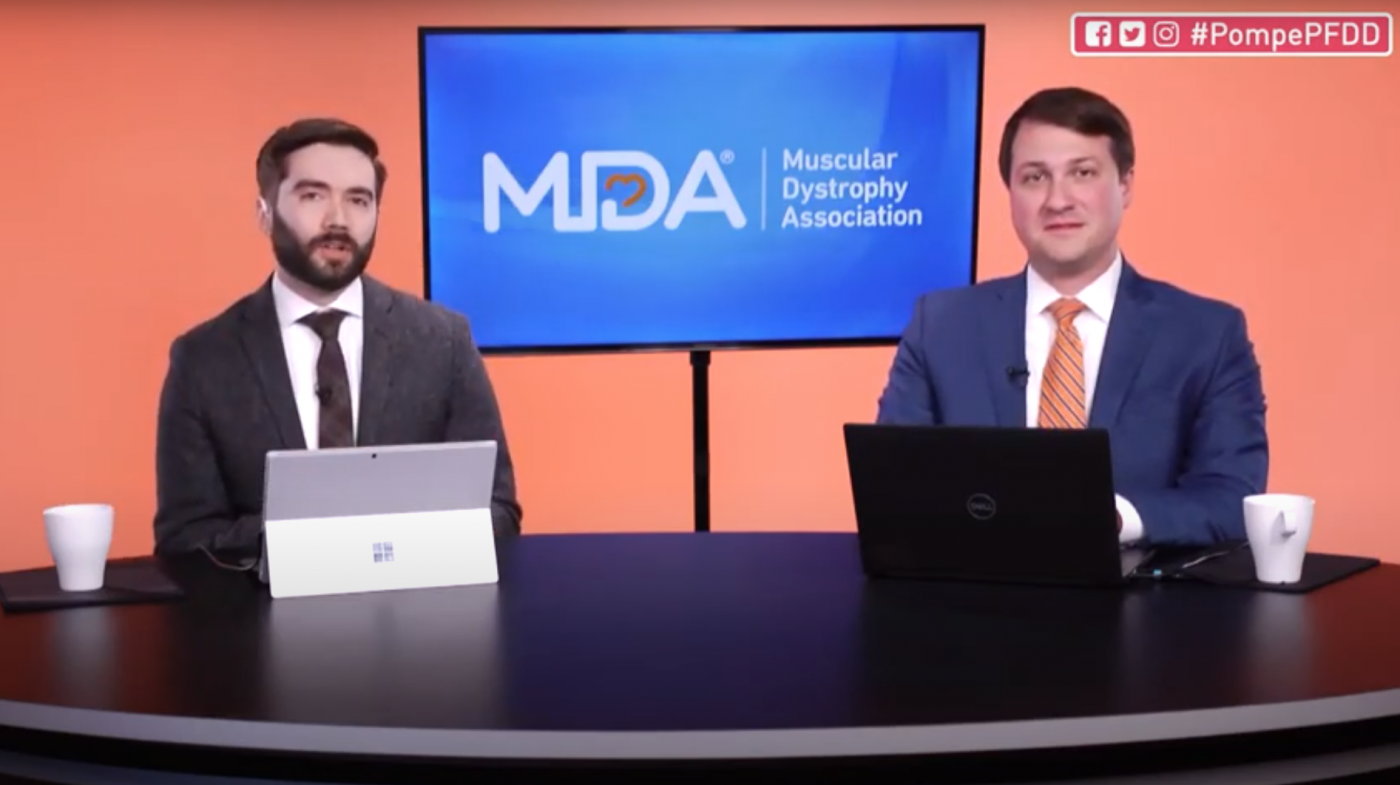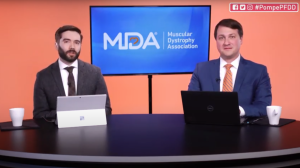MDA’s Virtual Drug Development Meeting Brings Together Pompe Patients, Industry

Paul Melmeyer (left), director of regulatory affairs at MDA and James Valentine (right), an associate at the law firm of Hyman, Phelps & McNamara, moderate the externally-led PFDD meeting. (Photo courtesy of MDA)
The Muscular Dystrophy Association (MDA) held its first externally led Patient-Focused Drug Development (PFDD) meeting on Pompe disease earlier this week.
The July 13 virtual PFDD meeting allowed Pompe patients and family members to share their experiences living with the disease with representatives from the U.S. Food and Drug Administration (FDA) and pharmaceutical companies.
“In order for new treatments to truly make a difference, it must be meaningful for the community it is intended for,” said Paul Melmeyer, MDA’s director of regulatory affairs and co-moderator of the online forum, in his opening remarks.

Paul Melmeyer (left), director of regulatory affairs at the MDA, and James Valentine, an associate at the law firm of Hyman, Phelps & McNamara, moderate the PFDD meeting. (Photo courtesy of MDA)
This PFDD meeting, like the 28 previously led by the FDA, helps inform the regulatory authority on new therapy approvals and guides decision-making on existing treatments. Over the course of the five-hour livestream, the Pompe community discussed gaps in treatment, the symptoms most difficult to live with, and changes in the diagnosis over time.
For Meg Haberman, the mother of a 6-year-old with Pompe, the PFDD meeting was a rare opportunity to connect with those in a disease community that affects one in 40,000 people in the U.S.
“It’s just helpful to hear other people’s perspectives to know we’re not in this alone,” Haberman, who lives in Sioux Falls, South Dakota, told Pompe Disease News by phone following the broadcast.
MDA split up the virtual meeting into three sessions: the symptoms of infantile and early-onset Pompe disease; the daily impact of late-onset Pompe disease; and current and future treatment options.
Participants were live polled and entered comments during sessions and expert remarks. MDA announced it’s keeping the live comment form up on the PFDD event page for 30 days.
During the opening segment of the event, Kathleen Donohue, MD, acting director of the FDA Division of Rare Diseases and Medical Genetics, spoke about the importance of the “Voice of the Patient Report,” which is compiled after the PFDD meeting.
Donohue said these reports can help persuade biotech companies to pursue broader enrollment and focus on clinical trial goals that better match the patient population’s needs.
She also addressed concerns related to the novel coronavirus, including potential lags in the drug development pipeline. It “remains a top priority for the agency even in the middle of the pandemic,” Donohue said.
Paloma Juarez, the mother of a child and child-to-be with infantile-onset Pompe disease, kicked off the first patient session. Her son, now 4 years old, started his Lumizyme (alglucosidase alfa) infusion at 23 days old and returned to normal heart function after 6 months.
Lumizyme, an enzyme replacement therapy and the only treatment available for Pompe disease, was developed by Sanofi Genzyme and approved in 2010. It is marketed in Europe under the brand name Myozyme.
The longest portion of the session, as with the following two, was a Zoom videoconference call with a panel including Juarez and other parents of young children with Pompe. They answered questions on topics ranging from barriers to certain activities because of Pompe and potential fears and worries as patients grow older.
As the PFDD meeting moved on toward the second panel, Sean Doerr, diagnosed with late-onset Pompe disease, described his struggle to get an accurate diagnosis and how the disorder has caused more fatigue and made walking and breathing increasingly difficult.
Barry Bryne, MD, PhD, director of the Powell Gene Therapy Center at the University of Florida and the MDA’s chief medical advisor, explained treatment options available now and in the future, including enzyme replacement therapy, liver-directed gene therapy, and stem cell gene therapy.
“Our stories are being heard,” Haberman said. Her son, Isaac, has had 89 Lumizyme infusions since beginning the treatment in 2017. “Things are progressing in a way where there might be a cure or better treatment for the future.”
Tiffany House, president and CEO of the Acid Maltase Deficiency Association; Wilson Bryan, MD, director of the Office of Tissues and Advanced Therapies at the Center for Biologics Evaluation and Research; and Priya Kishnani, MD, chief of the division of medical genetics at Duke University, also spoke at the PFDD meeting.
The FDA approved the PFDD meeting in November and the MDA expected to host the event in-person in Washington, D.C.; however, COVID-19 considerations forced the organization to move the meeting online.






